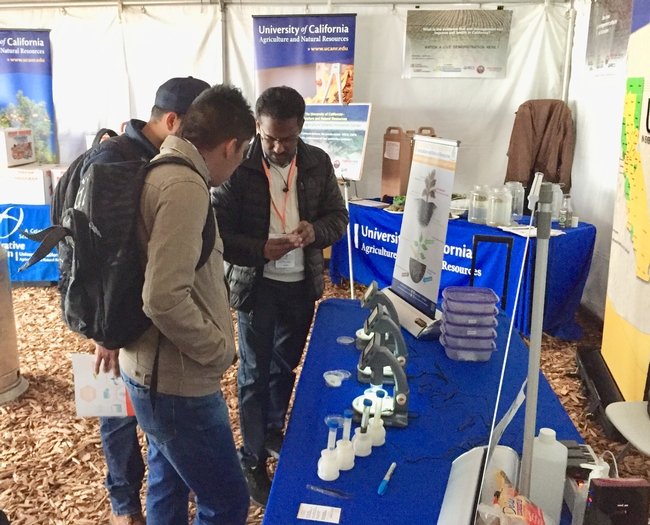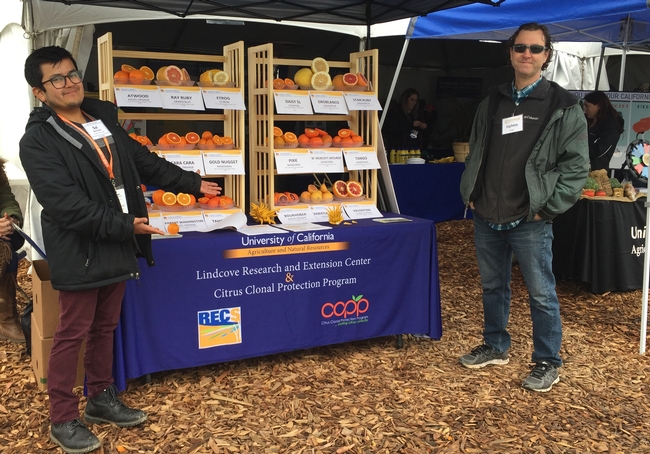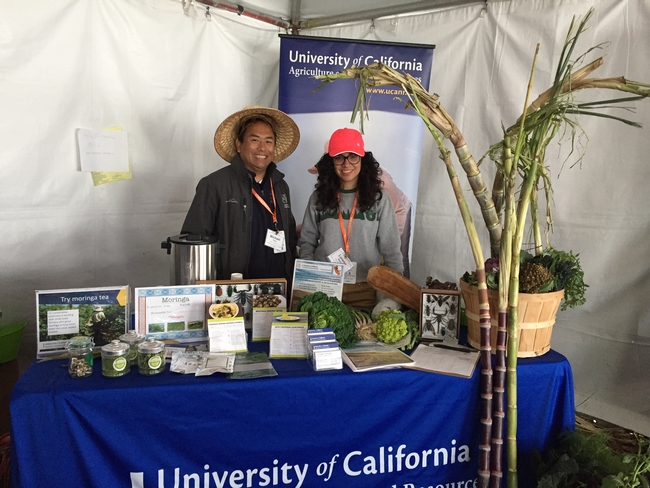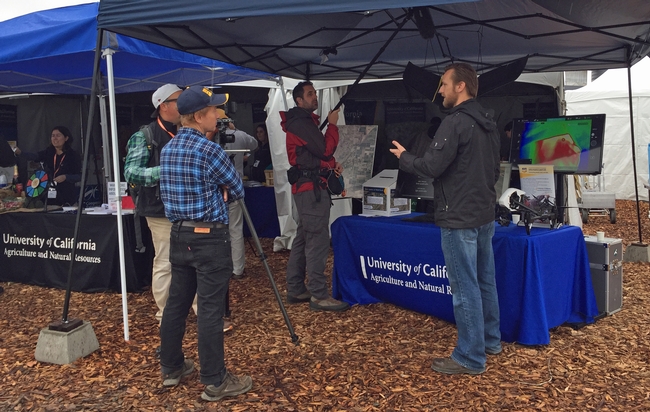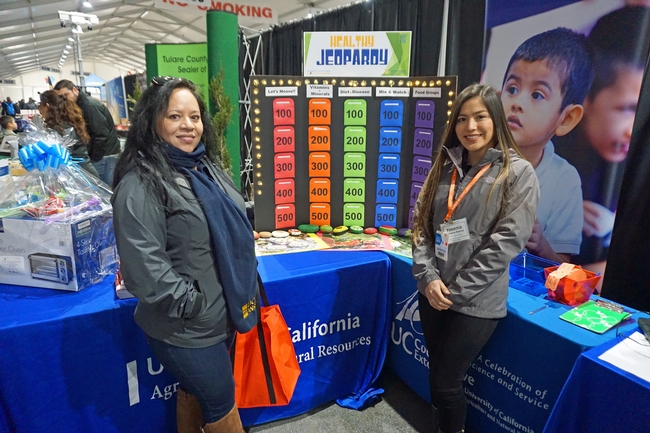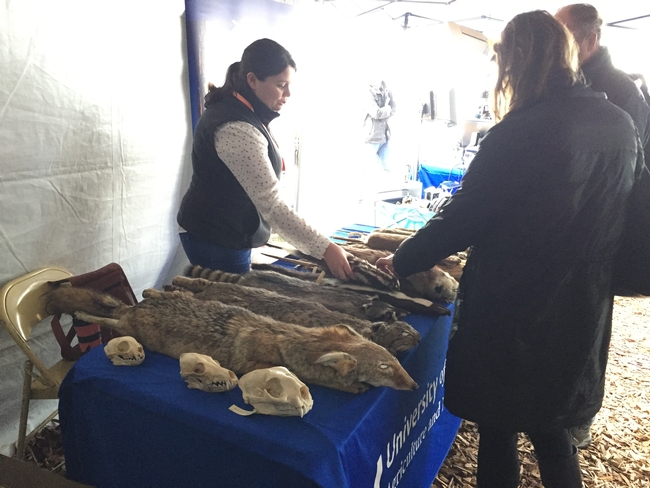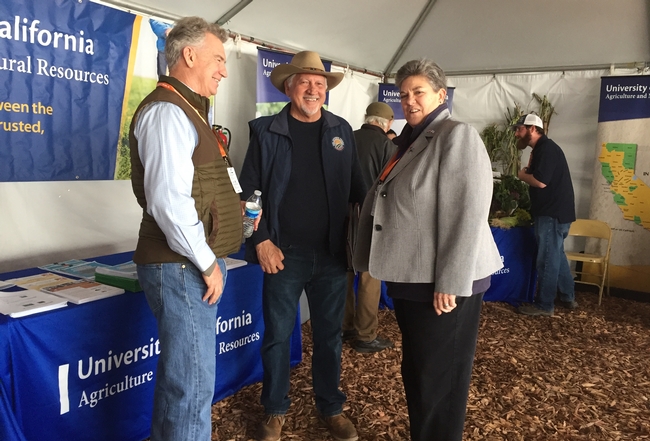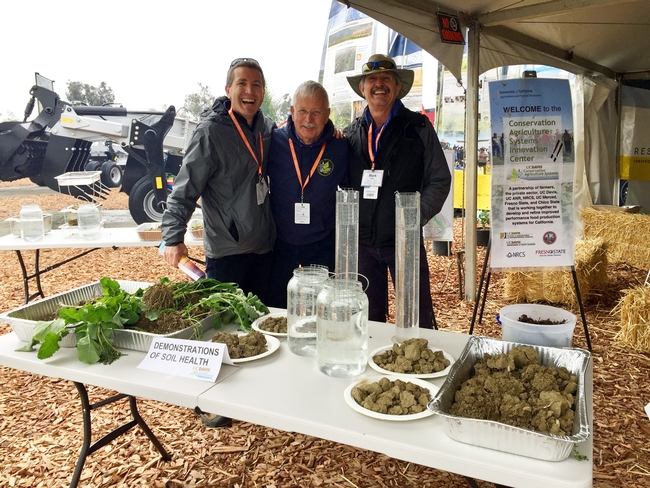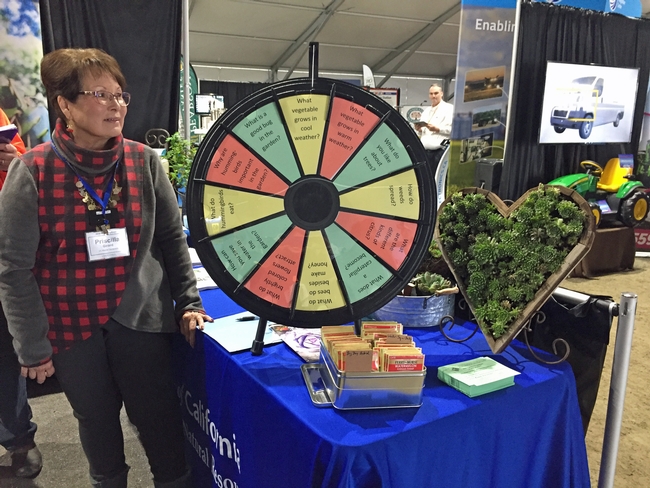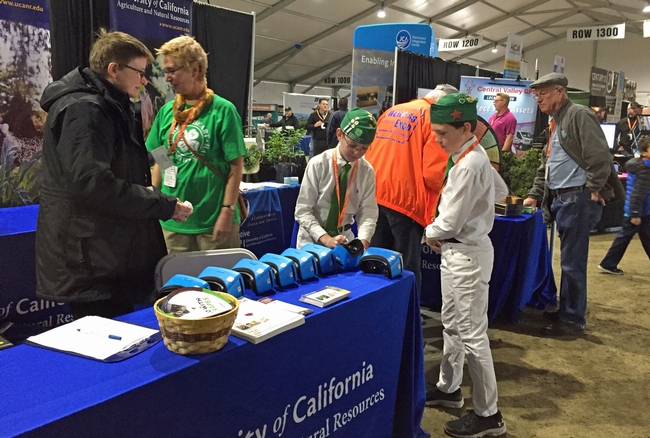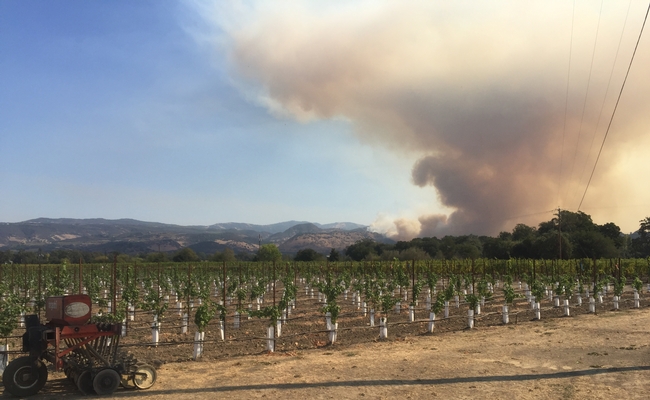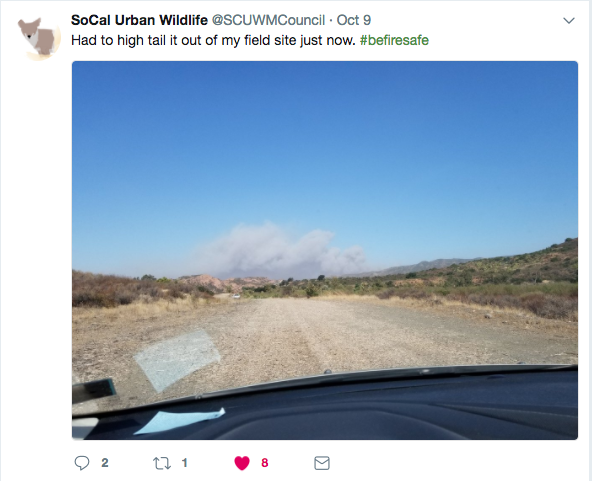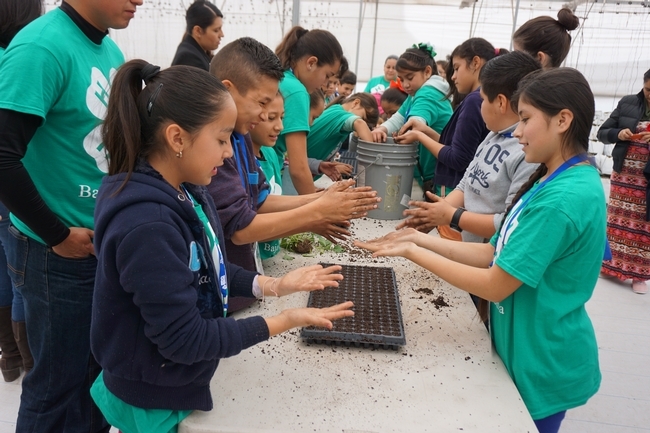Posts Tagged: Niamh Quinn
ANR meets the public at World Ag Expo
People from across California and around the world got to taste new crops, see research demonstrations and learn about several UC ANR activities at the World Ag Expo Feb. 12-14. Despite the cold rainy weather, the world's largest agricultural exposition attracted 102,878 people representing 48 states, the District of Columbia and 65 countries to Tulare.
At an outdoor tent, Beth Grafton-Cardwell, UC Cooperative Extension specialist, Greg Douhan, UCCE citrus advisor, and other researchers, handed visitors fresh Tango citrus grown at the Lindcove Research and Extension Center and told them about their citrus variety research.
Ruth Dahlquist-Willard, UCCE small farms advisor, and Michael Yang, small farms and specialty crops agricultural assistant, encouraged visitors to taste moringa tea. Surendra Dara, UCCE entomology and biologicals advisor, described how Bagrada bugs and other pests under the microscopes can be controlled by microbes. Roger Baldwin, UCCE wildlife specialist, and Niamh Quinn, UCCE urban wildlife conflict advisor, took turns showing taxidermy vertebrate pests and describing their management research.
Jeff Mitchell, UCCE specialist, and Jeff Dahlberg, Kearney Agricultural Research and Extension Center director, gave demonstrations to show the superior health of soils managed with conservation techniques.
Demonstrating the use of high-tech in agriculture, Sean Hogan, Informatics and Geographic Information System academic coordinator, Andy Lyons, IGIS program coordinator, and Jacob Flanagan, IGIS programmer, showed how they use drones and cameras in agricultural research.
Inside Pavilion A, Teresa Rios-Spicer, UCCE nutrition program manager, andYeseniaMedrano, UCCE community education specialist, both from Tulare County, challenged visitors to test their nutrition knowledge by playing Jeopardy! Visitors could spin the UC Master Gardeners prize wheel to answer gardening questions and win seeds. 4-H members invited youth to peer into virtual reality goggles to give them an idea about the fun activities that can be part of joining 4-H.
Frank Mitloehner, UC Cooperative Extension specialist, gave a seminar explaining confusion in the media about the amount of greenhouse gas livestock emit in California and globally. He reviewed the innovations in livestock production that are leading the way to a "greener future" for California and U.S. agriculture.
Beth Grafton-Cardwell, UC Cooperative Extension citrus entomology specialist, and Victoria Hornbaker of the California Department of Food and Agriculture, gave an update on regulatory protocols relating to Asian citrus psyllid and HLB quarantines and the proper transportation of bulk citrus to prevent the spread of the pest and disease.
The California and Dutch AgFoodTech innovation partners reunited in Tulare for a networking luncheon to share their action plan with invited guests and scope the projects.
UCCE spared by October wildfires
California will be dealing with the effects of the October 2017 wildfires for years to come. The Northern California wildfires that ignited Oct. 8 grew into urban conflagrations and burned for days, killing 43 people and destroying at least 8,400 structures.
In Southern California, Niamh Quinn, UC Cooperative Extension human-wildlife advisor, tweeted a photo after outrunning the Canyon Fire 2, which burned over 9,000 acres and destroyed 25 structures.
Brian Oatman, director of Risk & Safety Services, contacted UC Cooperative Extension employees in Sonoma, Napa, Marin, Mendocino, Lake, Butte, Sutter, Yuba and Orange counties and at the Hopland, Sierra Foothill and South Coast research and extension centers.
On Oct. 10, Oatman sent an email to the ANR community giving a status report on the UC ANR offices in the fire zones, saying, “We have heard that all employees are safe.” He added, “In many counties, staff know of 4-H or Master Gardener families who have lost homes or suffered damage.”
In Solano County, 17 UC Master Gardener volunteers, maybe more, lost their homes in the fires. The UC Master Gardener Program quickly set up an online form to connect Master Gardener volunteers throughout the state who wanted to offer lodging, supplies and words of support to fellow volunteers impacted by the fires.
In Sonoma County, UC Cooperative Extension staff and 4-H members helped rescue livestock.
ANR suffered no significant property damage, but some offices closed due to local evacuation orders.
Kaan Kurtural, UC Cooperative Extension viticulture specialist based in Oakville, said the viticulture research station went without electricity for 16 days. They brought in generators from UC Davis.
To help evacuated Californians who returned to their homes recover from fires, Strategic Communications created a story map with links to UCCE county resources.
News reporters sought out several UC ANR experts to explain why the wildfires spread so quickly and burned so intensely and how the fires would affect agriculture. See the ANR News blog for the monthly news roundup for October.
If you would like volunteer or donate to fire recovery efforts, check with local food banks or organizations such as Sonoma County Recovers to find out what is needed. If you would like to contribute to UC Master Gardener volunteers who are in need, you can fill out a survey that was created to connect resources with the affected volunteers: ucanr.edu/mgrelief.
AVP Powers announces 51 proposals invited for competitive and high-reward grants
AVP Wendy Powers announced the letters of intent (LOIs) for which principal investigators have been invited to submit full proposals to ANR's Competitive Grants Program and High-Risk/High-Reward Grants Program. The list of 51 approved projects can be found at http://ucanr.edu/sites/anrstaff/files/261626.pdf.
This year ANR received a total of 108 letters of intent — 97 for the Competitive Grants Program and 11 for the High-Risk/High-Reward Grants Program. Strategic Initiative leaders and their respective panels reviewed all letters of intent thoroughly to address the appropriateness of the proposals in addressing the goals and criteria outlined by each funding opportunity.
ANR Competitive Grants Program
The purpose of the ANR competitive grants program is to address high-priority issue areas identified by at least one of the strategic initiatives: Endemic and Invasive Pests and Diseases (EIPD), Healthy Families and Communities (HFC), Sustainable Food Systems (SFS), Sustainable Natural Ecosystems (SNE), and Water Quality, Quantity and Security (Water).
ANR Competitive Grants Program 2017 Cycle:
- Full proposals due June 19
- Technical peer review: mid-June – early September 2017
- Strategic Initiative review and recommendations: end of September 2017
- Program Council review and recommendations: October/November 2017
- Announcement of funded grants: November/December 2017
High-Risk/High-Reward Grants Program
Given the complexity of societal problems, high-risk research is necessary to achieve gains for real progress in addressing present and emerging challenges. This program will provide funds to initiate and complete research and proof-of-concept efforts that serve as the basis for larger funding opportunities. These projects must be of a high-risk/high-reward nature that are best conducted in a controlled, research setting and, if successful, lend themselves to subsequent larger funding opportunities and/or intellectual property development.
Proposed projects must be within the scope of the ANR Strategic Vision. All ANR academics with PI status are eligible to apply. Proposals will be accepted using the same timeline as outlined for the traditional competitive grants program, but reviewed separately due to the nature of the proposal.
For questions about ANR's competitive grants program or high-risk/high-reward grants program, please contact Melanie Caruso at mmcaruso@ucanr.edu.
Nutrition Policy Institute launches Research to Action news brief
The Nutrition Policy Institute has launched a news brief called Research to Action. The publication will provide information on research, policy, news, announcements, events, articles and action items focused on nutrition and healthy communities.
The first issue looks at the work of the National Drinking Water Alliance (NDWA). NPI is the “hub” for NDWA, which engages in and coordinates evidence-based efforts going on all over the country to improve tap water safety and access, especially for children, and to provide drinking water education and promotion. The NDWA website is a “go-to” resource for information on drinking water.
Future editions of Research to Action will be sent several times per year. Please sign up for the Research to Action mailing list, and please share Research to Action with colleagues who would be interested in receiving it.
4-H calls alumni and friends to join its new network
If 4-H has touched your life, raise your hand. Visit http://4-H.org/raiseyourhand to voice your support for the California 4-H youth development program, help it win a national competition and connect with a network of 4-H alumni and friends.
You are considered alumni if you were in a 4-H Club, took part in a 4-H after-school program, served as a volunteer leader or taught a project. Friends of 4-H are also invited to raise their hands.
“Having experienced our programs first-hand, our alumni know about the positive impact of 4-H,” said Glenda Humiston, vice president of UC Agriculture and Natural Resources and a 4-H alumna.
As part of the new 4-H network being built in the 4-H Raise Your Hand campaign, members will get news about 4-H programs in California and stay in touch with a program that made a difference in their lives.
“I've raised my hand,” said Humiston, who credits 4-H with helping her become the first in her family to attend college. She later served in the Peace Corps, received a federal appointment from President Obama and now leads the statewide research and outreach arm of UC.
The National 4-H program, which currently empowers nearly 6 million youth across the country, aims to extend its reach to 10 million by 2025. It has launched a competition among states to see which ones can add the most alumni and friends to the network by June 30, 2017. A map showing the current front runners is on the registration page.

